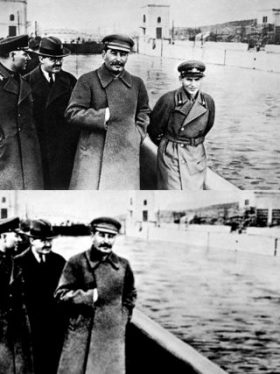PARENTAL ADVISORY: some photos contained in this post may be disturbing for children.

A scene from Reservoir Dogs vs. the murder of the Russian Ambassador in Turkey. (Photo: Burhan Ozbilici)
In my last post I highlighted how easy it is to fall in love with a narrative, especially if it paints someone we don’t like as the culprit and/or it gives us the impression of being smarter than others.
But in today’s media landscape, when you are bombarded with messages, photos and videos selectively perfected to capture your attention, where fashion models are routinely photoshopped and people merrily tweet and send unverifiable videos from war zones, a new question arises. Can you even trust your own eyes?
Truth is elusive. The world is full of deception. Random events that seem to hide a deeper meaning; fabricated stories; manipulated images; some half-truth pitted against an opposite half-truth.
Reality imitates Art
Take the opening image. It’s meant to be both fascinating and disturbing.
The first scene is from Quentin Tarantino’s masterpiece Reservoir Dogs. It’s a brutal movie, cleverly playing with our expectations and cinematic clichés to convey more intensity. It’s crude and offensive; but it’s far from trivial. It’s stylish-crude. It’s a sort of intellectual challenge. A close-up look projecting us into a room full of desperation, hope, cruelty and swagger.
That’s Tarantino’s gift: the result is surreal but it feels closer to reality than any other movie.
The second scene is from the assassination of the Russian Ambassador in Istanbul on December 19. Here the Islamist terrorist and killer, a Turkish policeman, had the opportunity to dress for the event: a photo exhibit presentation, in a modern art gallery in a swanky neighborhood. The seemingly artificial, polished environment, his black suit contrasting with the whiteness of the surroundings bring an eerie air of unreality to the photo.
It’s real and horrible, but it feels like a sequence from a movie.
Am I being disrespectful to a dead man? Some outlets blurred or left out the image of Ambassador Andrey Karlov laying dead on the floor.
I wanted the effect to be as close as possible to a (virtual) stomach punch. The point is that there’s nothing telling you the body on the foreground isn’t an actor, other than the knowledge of what happened.
Are we becoming desensitized to violent imagery?
Our culture has been successful in hiding the very nature of death; death and violence almost vanished from our lives and were relegated to cheap entertainment. But now we are being confronted by thugs that embrace death and are counting on our inability to react to shocks.
Can you put your finger on what the opening image means to you? Are you prepared to face unsettling situations, where there’s no comfy couch for you to sit on and watch?
Besides. Is it even possible to tell a real photo from a fake one?
Art creates a New Reality
A novel writer has always been more powerful than God: inside the imaginary universe contained within the covers of a book, in fact, an author has the ability to make literally anything happen, while God himself chose to restrain his intervention by setting certain rules for the Universe and keeping reality consistent (miracles are a possible exception, but besides being extremely rare, they too follow a pattern).
In a work of fiction a protagonist could easily win a fortune by gambling away his last few dollars in a casino; the action hero can jump from helicopters or survive a Russian Roulette. And he’s so immeasurably awesome that the bad guys shooting at him will always miss!
During most personal journeys through life, your fictional alter ego will encounter a few prostitutes with a heart of gold, but any priest or authoritative figure will invariably hide a petty, ugly and evil nature behind a moralistic façade.
If a writer doesn’t accept the hard lessons of life, he can give credibility to a story where the opposite happens routinely. If his vision is shared and becomes popular, people could build a case against the truth, supported by their imaginary experience as readers.
The problem isn’t with suspension of disbelief itself; anyone can enjoy a fairy tale without being influenced into thinking that a pumpkin can be magically transformed into a carriage. The problem is with a kind of misrepresentation that is not obvious to the audience. Pretending that a certain idea works. Destroying the image of some historical figure, or elevating a mass murderer and his ideology.
This brings us the art of Leni Riefenstahl, a very talented photographer and director that created powerful propaganda documentaries for the Nazi regime.
The advent of cinema revolutionized the game. The irresistible nature of images is capable of winning over any but the most determined skeptics.
When someone tells us a story, we are aware of the possibility that it may contain mistakes, inaccuracies or a deliberate deception.
But our brains are not wired to question the veracity of what we see with our very own eyes.
Motion pictures and reportage videos are extremely effective in conditioning us.
Example. A movie narrates the endearing story of a kid who happens to be raised by two daddies, a happy kid whose only troubles come from ignorant homophobic neighbors using insulting words and mistreating them (but they’ll eventually come around and embrace the new family’s lifestyle). Viewers will feel closer to the cause of gay marriage afterwards. “See, it’s normal. I’ve seen them living a life like ours, only being discriminated against by cold-hearted bigots!”
The message is reinforced through repetition. Lots of movies, plays, novels and articles pointing in the same direction.
Reality should cave in: the real world is flexible because any consequences become apparent only after many years, and even then the connection could still be denied through rhetorical exercises with the help of ad hoc biased research. The fictional world is inflexible instead: ideological alignment guarantees a strong message.
Your future is not yours; it’s dependent on the will of those who know how to create strong imagery. But they don’t control it either; to be successful, they must adhere to the movement, they must be part of a natural trend towards entropy. In other words: disorder, disrupting the progress of a civilization.
In this example, denying a child the essential emotional presence of a father AND a mother represents an extraordinary step to remove a building block from our human nature.
Our mind is ill-prepared to face a complex reality and it’s easily manipulated.
We are controlled through what we see.
Manipulating images

Photo manipulation classics. A disgraced Nikolai Yezhov (arrested and shot during the Purges) disappearing from Stalin’s side after a retouch
This is easy and I’ll just touch on it quickly.
In this time and age it’s becoming increasingly easy to fabricate an alternate version of reality through image manipulation.
Retouching photos is almost as old as photography; yet the recent example of the Star Wars movie Rogue One, where the long deceased actor Peter Cushing has been substituted by a virtual actor, has sparked a lot of interest.
In a future where speech synthesis and other aspects of simulations pertaining facial expressions will be perfected, it will become almost impossible to tell if a certain person portrayed in a video is real or not, except based on the credibility of the source.
And we’ve all had the opportunity to appreciate the level of reliability of the mainstream media: outlets that often produce deeply biased if not deceptive reports while breathlessly denouncing the fake news phenomenon from alternative media.
It’s not just that we won’t trust a certain journalist; we won’t be able to trust what we see and hear!
Reimagining images
The fact that our understanding of the world has radically changed thanks to our new focus on visual media (and the abundance of it) can be exemplified considering the post-9/11 conspiracy theories.
Humanity was used to taking for granted that a piece of news about a distant battle, a sketchy report often coming weeks after the events, was useful and trustworthy enough to accept it at face value.
Here’s the paradox. Nowadays we are usually able to obtain an unprecedented amount of data on a newsworthy event. And yet almost invariably scores of people don’t trust the “official version” of what happened, i.e. a factual description of what was witnessed by many and captured by cameras, subsequently verified by experts. Worse still, it’s precisely when the evidence is abundant that conspiracy theories flourish!
The more we are able to know, the less we believe.
There aren’t many conspiracy theories about the Islamists that murdered Ambassador Stevens and others in Benghazi in 2012: there’s not enough material to capture the curiosity of the general public (and the truth is too disturbing for most). Even fewer people question the US Government’s assumptions about Assad’s regime and the “moderate” rebels, in part because there’s no juicy video material on which the usual suspects could focus on and obsess about.
Instead there’s been an incredible amount of debate about the 9/11 attacks, despite their being one of the most documented events in history…
The thing is, the more data you collect, the easier it is for people to misunderstand a detail, to believe they found a smoking gun here and there.
The same could be said about the Apollo Moon missions: there’s enough footage to rummage through in order to come up with some creative nonsense, denying facts that are proven beyond even unreasonable doubt.
Try to distance yourself a bit from what you know about 9/11 and assess objectively the absurdity of alternative theories: since the plane hitting the Pentagon wasn’t captured on camera like the two hitting the Twin Towers, it didn’t happen, tens of human witnesses notwithstanding. They must have made it disappear while flying over Washington (!), never to be retrieved. Then they must have hit the Pentagon with a missile (?), subsequently scattering parts of the plane and some charred bodies with the DNA of the passengers within and around the hole caused by the missile, while firemen where fighting the fire. Plus many more details needing some “adjustments”. For no reason whatsoever!
Why? Because no footage! Ugh!
Living in the Age of Information means that we are flooded with so much information that we lose the ability to process it. The ability to sift through all the garbage and to maintain a grasp on reality.
Anyone can steer our attention to a certain iconic image, to a series of selected details that reinforce our prejudices.
We watch, but we don’t see. We see, but we don’t understand. A shadow becomes a metal part protruding from a plane. A widely publicized photo of a dead body becomes the symbol of the side we should choose to support during a conflict, regardless of who killed more enemies or more civilians.
We are overwhelmed by images.
Inventing Reality

Photos coming from a war zone are the most difficult to verify. The stakes are very high, the propaganda value is immense. Reporting from a dangerous location is also often problematic.
There’s plenty of misattributed photos, lazily recycled from earlier conflicts by news agencies and activists.
But then, what about staged photos? This is a staple of Palestinian propaganda; you recreate a scene where some civilians (better: children) appear to be the victims of some vicious attack by the enemy. But the ruse is often unmasked, eventually. For instance a purported missile impact crater is revealed through expert analysis to be compatible only with the explosion of a hand grenade. A photo of a mourning child next to a tomb is followed by another photo, clearly shot in the same occasion, where the kid is smiling as nothing happened.
It’s a delicate subject: you always run the risk of accusing a real victim of being an impostor. Besides, beyond the machinations of the propaganda, there are real people suffering anyway; but maybe not in a manner that can be easily weaponized through a camera…
Let’s focus on the conflict in Syria.
The 4 unsettling photos presented here underline the ugly nature of war, but how can we tell they are all authentic?
The 1st and 3rd images are taken from media reports coming from East Aleppo, on the side of the Assad regime; they received minimal international coverage. No one questions the veracity of those images. They don’t even look staged or professionally taken.
The 2nd and 4th photos come from West Aleppo before the successful retake by Assad’s troops; in other words, they come from the part of the town that was controlled by the “rebels”, i.e. the bloodthirsty Islamist extremists (mostly foreigners) that the Western Powers pretended were representing a viable future for the country. We’ll need to spend some words another time to discuss this ugly choice. But the point is: the western media seemed eager to give these extremists a free pass. To exaggerate their grievances and undermine their shortcomings.
The woman in the 2nd image is apparently injured only on the most visible spot, on the forehead. The photo itself has been challenged by others and -if taken out of context- could be mistaken for a theatrical performance of sorts. Real or fake?
The 4th photo is probably the only one you already saw: it’s been widely disseminated. This boy seemed to have been injured in a bombing by Assad’s army. Or maybe this particular incident was staged.
In fact there’s even a video where you can spot a couple of men getting close to the ambulance and filming the event. One of the 2 is identified as a specific journalist. He praised suicide attacks on his Facebook page; he’s also been depicted in another occasion proudly taking a selfie with two savage terrorists, murderers that became famous a couple of weeks before for another video where they behead a boy (!) in a cold blood execution.
What kind of people finds it OK to send both messages?
In the video of the rescue the kid of the photo is seen rubbing the large head injury with his hand. This may mean he felt no pain there, only a discomfort compatible with being dirty.
A man “casually” roams in front of the camera: he’s sporting again a garish blood splodge covering a side of his face.
These kind of injuries are not suspicious per se; but the whole idea of getting so many examples of victims that (besides being covered in fine white dust) appear in good health, safe for a showy blob of blood on the forehead is somewhat puzzling.
Again, there’s been lots of suffering in West Aleppo too. It’s been reported that a brother of the boy in the photo was killed in another attack.
Let’s say this “Aleppo boy” video is not fake after all.
I feel uncomfortable with the whole idea of questioning the authenticity of those photos.
This is the power of images!










































